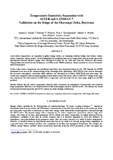Temperature-Emissivity separation with ASTER and LANDSAT 7 validation on the fringe of the Okavango Delta, Botswana

View/
Date
2004Author
Gieske, A.S.
Wubett, M.T.
Timmermans, W.J.
Parodi, G.N.
Wolski, P.
Arneth, A.
Publisher
SPIE, http://link.aip.orgType
Published ArticleMetadata
Show full item recordAbstract
Land surface temperatures are important in global change studies, in estimating radiation budget, heat balance studies and as control for climate models. Several algorithms for estimating land surface temperature and emissivity spectra for multispectral thermal infrared images were developed recently for use with data from the Advanced Spacebome Thermal Emission and Reflection Radiometer (ASTER) on the TERRA platform. Similar methods are also used with the MODIS instrument. In this study, surface temperature and broadband emissivities were determined from the five TIR channels of ASTER instrument in an area on the southern fringe of the Okavango Delta (Botswana). MODTRAN 4 was used to determine the necessary atmospheric corrections while software was developed to facilitate MODTRAN post-processing. The results were compared with micrometeorological observations from a flux tower, with a LANDSAT 7 image of the same day, and finally also with reported ASTER surface temperature and emissivities for the same image (high level ASTER product). Results indicate that the surface temperature depends rather sensitively on atmospheric transmissivity and relatively large temperature differences are found between results from imagery analysis and flux tower. No relation was found between broad-band emissivity and NDVI, contrary to earlier findings in Botswana.
Collections
- Research articles (ORI) [270]
